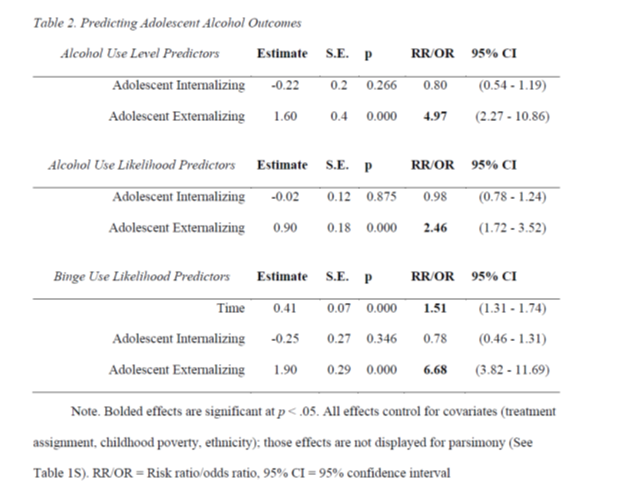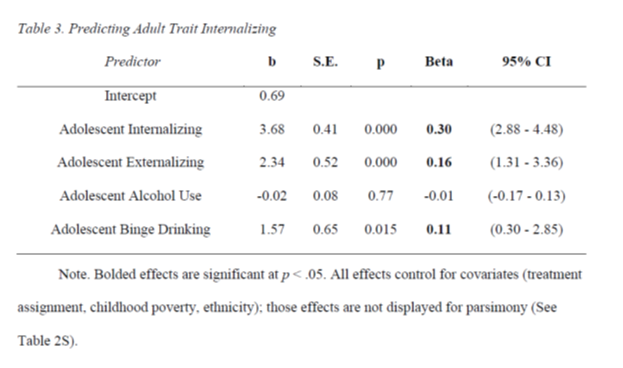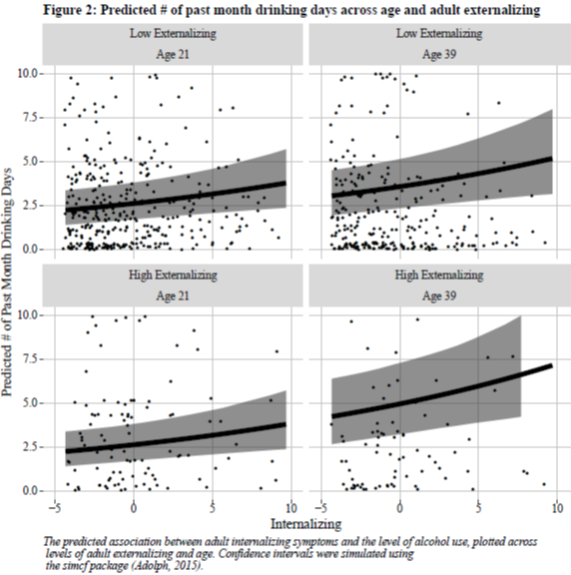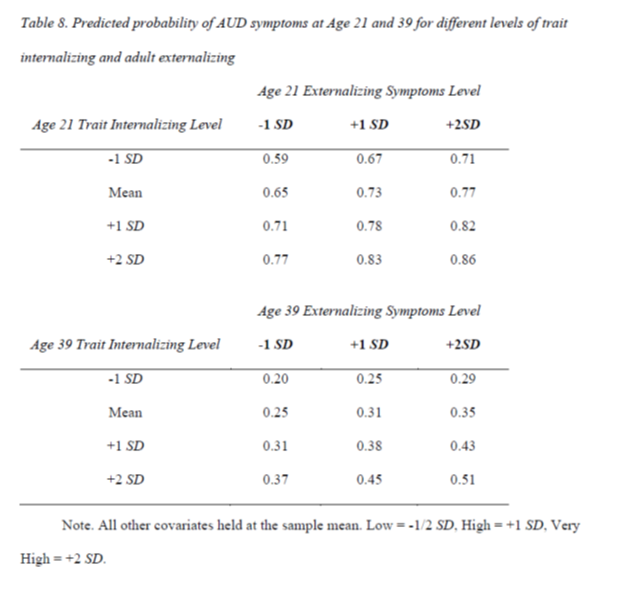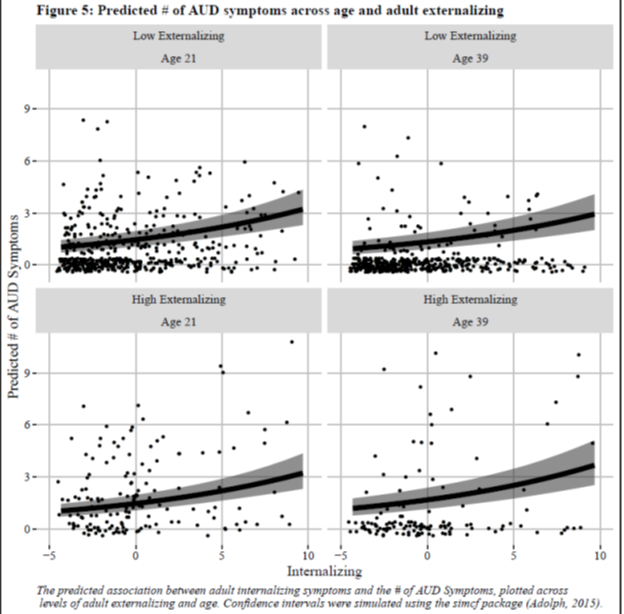New paper from our lab, for @AddictionSciJC.
Common variance across MDD, GAD, and social anxiety disorders is related to problem alcohol involvement in young adulthood, but not during adolescence. W/ @madifeil, @MaxAHalvorson , and the folks at SDRG
https://psyarxiv.com/u5agc
1/25">https://psyarxiv.com/u5agc&quo...
Common variance across MDD, GAD, and social anxiety disorders is related to problem alcohol involvement in young adulthood, but not during adolescence. W/ @madifeil, @MaxAHalvorson , and the folks at SDRG
https://psyarxiv.com/u5agc
1/25">https://psyarxiv.com/u5agc&quo...
Alcohol researchers have long hypothesized that the experience of internalizing symptoms (like those of depression and anxiety) are related to the development of alcohol use disorder (AUD) through negative reinforcement mechanisms.
2/25
2/25
In other words, some people are thought to develop AUD because they drink to relieve the negative emotions caused by depression and anxiety. It might be true, but the evidence is mixed as to whether people with internalizing sx. are at higher risk for AUD
3/25
3/25
Theories of “trait internalizing” ( @hitop_system) suggest that some people are more likely to report symptoms of and meet criteria for multiple internalizing disorders such as MDD, GAD, social phobia, and others across their lives.
https://doi.org/10.1037/a0024406
4/25">https://doi.org/10.1037/a...
https://doi.org/10.1037/a0024406
4/25">https://doi.org/10.1037/a...
A few prior studies had show that trait internalizing was moderately correlated (r = .38 - .49) with alcohol use disorder in young adulthood, while other studies have found less support during adolescence.
For example, a paper by @KristieJ_Brown
https://doi.apa.org/doiLanding?doi=10.1037%2F0021-843X.112.4.599
5/25">https://doi.apa.org/doiLandin...
For example, a paper by @KristieJ_Brown
https://doi.apa.org/doiLanding?doi=10.1037%2F0021-843X.112.4.599
5/25">https://doi.apa.org/doiLandin...
Some research by Craig Colder had actually shown that trait internalizing was *protective* against alcohol use in adolescence, especially once comorbidity with externalizing symptoms (like conduct problems and ADHD) was accounted for.
https://link.springer.com/article/10.1007/s10802-017-0277-6
6/25">https://link.springer.com/article/1...
https://link.springer.com/article/10.1007/s10802-017-0277-6
6/25">https://link.springer.com/article/1...
We used a prospective sample of youth (n = 790) studied from the Seattle Social Development project ( http://sdrg.org/ ">https://sdrg.org/">... ), interviewed across 25 years. We used data from three waves in adolescence (ages 14-16), and 6 waves during adulthood (ages 21, 24, 27, 30, 33, 39)
7/25
7/25
We used GEEs ( @dmcneish18) to estimate the relation between average internalizing symptoms and trajectories of alcohol use and binge drinking in adolescence and adulthood, and with AUD symptoms in adulthood, controlling for ext.
https://psycnet.apa.org/doiLanding?doi=10.1037%2Fmet0000078
8/25">https://psycnet.apa.org/doiLandin...
https://psycnet.apa.org/doiLanding?doi=10.1037%2Fmet0000078
8/25">https://psycnet.apa.org/doiLandin...
We used hurdle negative binomial models to predict levels and change over time in the past month # of drinks and AUD sx., and logistic GEEs to predict levels and change in binge drinking.
9/25
9/25
We tested separate models in adolescence and adulthood, and then tested whether adolescent internalizing was associated with adult alcohol outcomes via its relation with adult internalizing.
10/25
10/25
In adolescence, trait internalizing did nothing; all the action was carried by externalizing. This is like noting that the ground gets wet when it rains. Everybody knows that externalizing symptoms matter a lot for alcohol outcomes in adolescence.
11/25
11/25
One big limitation: we had different measures of trait int/ext in adolescence (Achenbach) and young adulthood (DSM-IV symptoms), so we can’t rule out that measurement differences account for differences across developmental periods
12/25
12/25
And indeed, trait internalizing in adolescence and adulthood were only moderately associated (B = .31), so there’s some, but not tremendous, continuity of internalizing across measures and developmental period.
13/25
13/25
In the next set of models, we predicted adult alcohol use behaviors (alcohol use, binge drinking, and AUD symptoms) from adult trait internalizing, controlling for alcohol use & internalizing in adolescence, and externalizing at both developmental periods.
14/25
14/25
Adult trait internalizing was not related to whether or not people reported drinking in adulthood, but it was related to *how much* people reported drinking (Ext. sx, even moreso!).
15/25
15/25
Because the values of all covariates influence model predicted estimates ( https://twitter.com/KMKing_Psych/status/1248003837576671232),">https://twitter.com/KMKing_Ps... you need to estimate them at specific values of covariates.
16/25
16/25
Since age and externalizing were strong predictors of alcohol behaviors, we modeled predicted counts at -1/+1 SD of trait externalizing, and at ages 21 and 39.
You can see across all levels, the predicted number of past month drinks increased as a fx of trait internalizing
17/25
You can see across all levels, the predicted number of past month drinks increased as a fx of trait internalizing
17/25
This was also true of the probability of binge drinking or AUD symptoms, and the # of reported AUD symptoms.
18/25
18/25
We made tables and figures to illustrate this effect, showing how relative increases in trait internalizing were related to the probability or level of AUD symptoms across age and levels of externalizing symptoms.
19/25
19/25
This shows how the model predicted # of AUD sx varied as a fx of internalizing across age and levels of concurrent ext
20/25
20/25
We looked for, but found no evidence, that these effects varied by gender.
21/25
21/25
Finally, b/c of the modest continuity of the adol & adult measures, we argue that we show support for a mediation hx: adol “trait” internalizing is associated with later problem alcohol use b/c it marks people who continue to have stable internalizing problems as adults
22/25
22/25
So what does this all mean?
We think it shows some evidence that perhaps those of us looking for an internalizing/alcohol link in adolescence and early adulthood have been looking, perhaps, too young.
23/25
We think it shows some evidence that perhaps those of us looking for an internalizing/alcohol link in adolescence and early adulthood have been looking, perhaps, too young.
23/25
There’s lots of things going on in youth that influences drinking (social contexts, peer norms, ext behavior). If there is a causal effect of anxiety/depression on problem drinking, it might not appear until after drinking is well established and alcohol readily available.
24/25
24/25
This may also be a reflection of a shared etiological factor, like negative urgency, which causes both trait internalizing ( https://journals.sagepub.com/doi/abs/10.1177/1073191120983889)">https://journals.sagepub.com/doi/abs/1... and alcohol problems.
25/25
25/25

 Read on Twitter
Read on Twitter